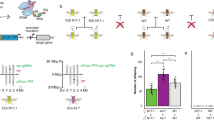Summary
1. The phenocopy “dumpy”, produced by 40°C treatment of 16–18 hour pupae, was selected for 30 generations. The duration of treatment was gradually reduced from 4 1/2 to 2 hours. Phenocopy frequency in the last generation was 95%.
2. In untreated flies weakly dumpy wings first appeared in generation 25. From these an assimilated stock was established in which, after 8 generations of selection, penetrance was 58%.
3. The genetical analysis of this stock showed that assimilated dumpy is produced only in the presence of the recessive lethal genedp TP2.
4. There is evidence that a second recessive lethal gene, which forms withdp TP2 a balanced lethal system, enhances, and possibly is obligatory for, the production of the dumpy phenotype bydp TP2.
5. The frequency ofdp TP2, and possibly also of the second gene, was increased by phenocopy selection; the frequency of both genes was increased by selection without treatment.
6. Successful selection for expression in the assimilated dumpy stock indicated that modifying genes are also involved. The assimilation of dumpy, like that of crossveinless, appears therefore to have depended on major-genes and modifiers.
7. It is suggested thatdp TP2 arose during the course of phenocopy selection as a consequence of the hot-shock treatment, and that this is the major difference between the dumpy and crossveinless experiments.
Similar content being viewed by others
References
Bateman, K. G. (1959). The Genetic Assimilation of four venation phenocopies.J. Genet. 56, 443–474.
Bridges, C. B. &Brehme, K. S. (1944).The mutants of Drosophila melanogaster. Carnegie Institution of Washington Publication No. 552.
Schatz, E. (1951). Uber die Formbildung des Flügels bei Hitzemodifikationen und Mutationen vonD. melanogaster.Biol. Zbl. 70, 305–353.
Waddington, C. H. (1939). Preliminary notes on the development of the wings in normal and mutant strains of Drosophila.Proc. Nat. Acad. Sci.,25, 299–307.
Waddington, C. H. (1940). The genetic control of wing development in Drosophila.J. Genet.,41, 75–139.
Waddington, C. H. (1956). Genetic assimilation of the bithorax phenotype.Evolution,10, 1–13.
Author information
Authors and Affiliations
Rights and permissions
About this article
Cite this article
Bateman, K.G. The genetic assimilation of the dumpy phenocopy. J Genet 56, 341–351 (1959). https://doi.org/10.1007/BF02984790
Issue Date:
DOI: https://doi.org/10.1007/BF02984790




